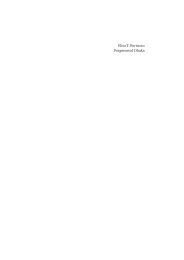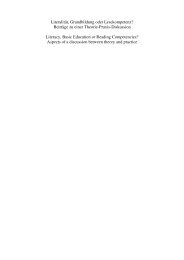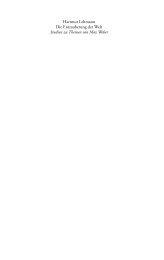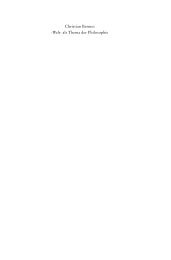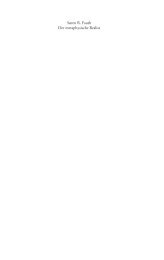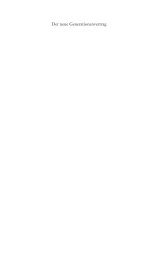The Wow Factor Global research compendium on the ... - E-cademic
The Wow Factor Global research compendium on the ... - E-cademic
The Wow Factor Global research compendium on the ... - E-cademic
Create successful ePaper yourself
Turn your PDF publications into a flip-book with our unique Google optimized e-Paper software.
More broadly, arts educati<strong>on</strong> is a relatively neglected area for scholarly investigati<strong>on</strong>.<br />
As Zimmerman (1994: 60) notes, <strong>the</strong>re has been c<strong>on</strong>siderable neglect of <str<strong>on</strong>g>research</str<strong>on</strong>g><br />
and practices related to arts teachers. This lack of <str<strong>on</strong>g>research</str<strong>on</strong>g> impacts negatively<br />
up<strong>on</strong> future directi<strong>on</strong>s in arts educati<strong>on</strong>. Additi<strong>on</strong>ally, Zimmerman (1994:<br />
65) c<strong>on</strong>tends that teachers and artists need to be encouraged to find a voice and to<br />
be empowered to seek <strong>the</strong>ir own meaning and understandings as <strong>the</strong>y engage in <strong>the</strong><br />
practice of arts teaching. <str<strong>on</strong>g>The</str<strong>on</strong>g> results of <strong>the</strong> <str<strong>on</strong>g>research</str<strong>on</strong>g> have shown a clear gap<br />
between <strong>the</strong> espoused policy – that value <strong>the</strong> arts within educati<strong>on</strong> – and <strong>the</strong> actual<br />
‘in school’ practices, that tend to fall significantly below <strong>the</strong> lofty aims existing in<br />
policy.<br />
While substantial studies into <strong>the</strong> benefits of art educati<strong>on</strong> have been undertaken in<br />
<strong>the</strong> United States (USA), Canada, Australia, Finland, <strong>the</strong> United Kingdom (UK)<br />
and o<strong>the</strong>rs, a comprehensive analysis had not been c<strong>on</strong>ducted of global <str<strong>on</strong>g>research</str<strong>on</strong>g> in<br />
arts educati<strong>on</strong>. Despite a range of studies indicating <strong>the</strong> benefits of <strong>the</strong> arts, <strong>the</strong> arts<br />
remain undervalued in many countries.<br />
Organisati<strong>on</strong> of <strong>the</strong> book<br />
<str<strong>on</strong>g>The</str<strong>on</strong>g> overall structure of <strong>the</strong> book has been designed to look comprehensively at <strong>the</strong><br />
state of arts educati<strong>on</strong> at <strong>the</strong> current point in time. <str<strong>on</strong>g>The</str<strong>on</strong>g> book utilises <strong>the</strong> data from<br />
<strong>the</strong> survey to present a wide-ranging picture of arts-rich educati<strong>on</strong> around <strong>the</strong><br />
world. <str<strong>on</strong>g>The</str<strong>on</strong>g> rati<strong>on</strong>ale behind <strong>the</strong> original <str<strong>on</strong>g>research</str<strong>on</strong>g> is that it would be valuable to<br />
capture <strong>the</strong> current state-of-play in relati<strong>on</strong> to arts educati<strong>on</strong> around <strong>the</strong> world and<br />
open this up for discussi<strong>on</strong> so that at a local level teachers and artists <strong>the</strong>y may be<br />
able to communicate aspects of <strong>the</strong>ir practice and beliefs, and at a nati<strong>on</strong>al or state<br />
level ministries of educati<strong>on</strong>, arts and culture and educati<strong>on</strong>al and cultural agencies<br />
may be provided with inspirati<strong>on</strong> for models of future arts-rich educati<strong>on</strong>. It is <strong>the</strong><br />
c<strong>on</strong>tenti<strong>on</strong> of this book that through c<strong>on</strong>versati<strong>on</strong>s, it is possible to differentiate <strong>the</strong><br />
present from <strong>the</strong> future and to think how <strong>the</strong> present and <strong>the</strong> future are likely to<br />
differ. It is within a framework of future acti<strong>on</strong> and improvement that <strong>the</strong> <str<strong>on</strong>g>research</str<strong>on</strong>g><br />
– and resulting book – is c<strong>on</strong>ceived.<br />
Since, earlier attempts to enhance <strong>the</strong> quality of l<strong>on</strong>g-term, classroom based<br />
outcomes of arts-rich educati<strong>on</strong> programmes seem to have been largely ineffectual,<br />
<strong>the</strong> book provided an opportunity to ga<strong>the</strong>r large-scale data and yet allow for <strong>the</strong><br />
presentati<strong>on</strong> of case studies that encouraged <strong>the</strong> full involvement of teachers and<br />
artists. In presenting <strong>the</strong> meta-analysis, <strong>the</strong> book tries to combine <strong>the</strong> statistical data<br />
with <strong>the</strong> voice of <strong>the</strong> resp<strong>on</strong>dents so that equal attenti<strong>on</strong> is given to <strong>the</strong> ‘big picture’<br />
as to <strong>the</strong> educati<strong>on</strong>al ecology surrounding arts-rich practices. It was equally<br />
significant to investigate what was happening in arts educati<strong>on</strong> today in a global<br />
and nati<strong>on</strong>al level as it was to examine <strong>the</strong> ways teachers, artists and <strong>the</strong><br />
24



